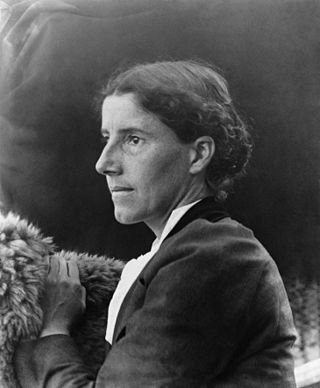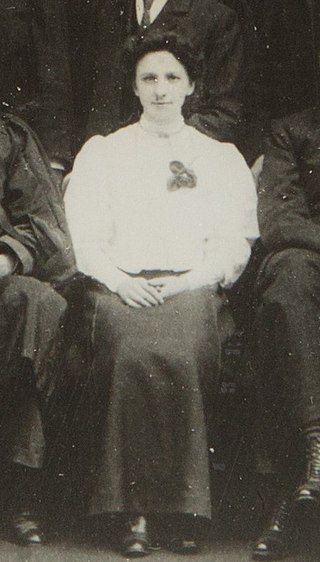Related Research Articles

Charlotte Perkins Gilman, also known by her first married name Charlotte Perkins Stetson, was an American humanist, novelist, writer, lecturer, early sociologist, advocate for social reform, and eugenicist. She was a utopian feminist and served as a role model for future generations of feminists because of her unorthodox concepts and lifestyle. Her works were primarily focused on gender, specifically gendered labor division in society, and the problem of male domination. She has been inducted into the National Women's Hall of Fame. Her best remembered work today is her semi-autobiographical short story "The Yellow Wallpaper", which she wrote after a severe bout of postpartum psychosis.
Liberal feminism, also called mainstream feminism, is a main branch of feminism defined by its focus on achieving gender equality through political and legal reform within the framework of liberal democracy and informed by a human rights perspective. It is often considered culturally progressive and economically center-right to center-left. As the oldest of the "Big Three" schools of feminist thought, liberal feminism has its roots in 19th century first-wave feminism seeking recognition of women as equal citizens, focusing particularly on women's suffrage and access to education, the effort associated with 19th century liberalism and progressivism. Liberal feminism "works within the structure of mainstream society to integrate women into that structure." Liberal feminism places great emphasis on the public world, especially laws, political institutions, education and working life, and considers the denial of equal legal and political rights as the main obstacle to equality. As such liberal feminists have worked to bring women into the political mainstream. Liberal feminism is inclusive and socially progressive, while broadly supporting existing institutions of power in liberal democratic societies, and is associated with centrism and reformism. Liberal feminism tends to be adopted by white middle-class women who do not disagree with the current social structure; Zhang and Rios found that liberal feminism with its focus on equality is viewed as the dominant and "default" form of feminism. Liberal feminism actively supports men's involvement in feminism and both women and men have always been active participants in the movement; progressive men had an important role alongside women in the struggle for equal political rights since the movement was launched in the 19th century.
The history of feminism comprises the narratives of the movements and ideologies which have aimed at equal rights for women. While feminists around the world have differed in causes, goals, and intentions depending on time, culture, and country, most Western feminist historians assert that all movements that work to obtain women's rights should be considered feminist movements, even when they did not apply the term to themselves. Some other historians limit the term "feminist" to the modern feminist movement and its progeny, and use the label "protofeminist" to describe earlier movements.

The Women's Social and Political Union (WSPU) was a women-only political movement and leading militant organisation campaigning for women's suffrage in the United Kingdom founded in 1903. Known from 1906 as the suffragettes, its membership and policies were tightly controlled by Emmeline Pankhurst and her daughters Christabel and Sylvia. Sylvia was eventually expelled.
Edward Harold Physick was an English writer, known chiefly as a critic and authority on John Milton; also, a poet and fantasy writer. He was credited as E. H. Visiak by 1909.

Dora Marsden was an English suffragette, editor of literary journals, and philosopher of language. Beginning her career as an activist in the Women's Social and Political Union (WSPU), Marsden eventually broke off from the suffragist organization in order to found a journal that would provide a space for more radical voices in the movement. Her prime importance lies with her contributions to the suffrage movement, her criticism of the Pankhursts' WSPU, and her radical feminism, via The Freewoman. There are those who also claim she has relevance to the emergence of literary modernism, while others value her contribution to the understanding of Egoism.
First-wave feminism was a period of feminist activity and thought that occurred during the 19th and early 20th century throughout the Western world. It focused on legal issues, primarily on securing women's right to vote. The term is often used synonymously with the kind of feminism espoused by the liberal women's rights movement with roots in the first wave, with organizations such as the International Alliance of Women and its affiliates. This feminist movement still focuses on equality from a mainly legal perspective.

The Egoist was a London literary magazine published from 1914 to 1919, during which time it published important early modernist poetry and fiction. In its manifesto, it claimed to "recognise no taboos", and published a number of controversial works, such as parts of Ulysses. Today, it is considered "England's most important Modernist periodical."

Harriet Shaw Weaver was an English political activist and a magazine editor. She was a significant patron of Irish writer James Joyce.

Rona Robinson was the first woman in the United Kingdom to gain a first-class degree in chemistry and one of the first documented female industrial chemists. She was also a British suffragette and paid member of the Women's Social and Political Union (WSPU).

Mary Eleanor Gawthorpe was an English suffragette, socialist, trade unionist and editor. She was described by Rebecca West as "a merry militant saint".
Social feminism is a feminist movement that advocates for social rights and special accommodations for women. It was first used to describe members of the women's suffrage movement in the late nineteenth and early twentieth centuries who were concerned with social problems that affected women and children. They saw obtaining the vote mainly as a means to achieve their reform goals rather than a primary goal in itself. After women gained the right to vote, social feminism continued in the form of labor feminists who advocated for protectionist legislation and special benefits for women. The term is widely used, although some historians have questioned its validity.
Feminism in China refers to the collection of historical movements and ideologies in time aimed at redefining the role and status of women in China. Feminism in China began in the 20th century in tandem with the Chinese Revolution. Feminism in modern China is closely linked with socialism and class issues. Some commentators believe that this close association is damaging to Chinese feminism and argue that the interests of the Chinese Communist Party (CCP) are placed before those of women. Under the Xi Jinping administration, feminist groups have been subject to increased scrutiny by the country's system of mass surveillance.

Mabel Henrietta Capper was a British suffragette. She gave all her time between 1907 and 1913 to the Women's Social and Political Union (WSPU) as a 'soldier' in the struggle for women's suffrage. She was imprisoned six times, went on hunger strike and was one of the first suffragettes to be force-fed.

The feminist movement, also known as the women's movement, refers to a series of social movements and political campaigns for radical and liberal reforms on women's issues created by inequality between men and women. Such issues are women's liberation, reproductive rights, domestic violence, maternity leave, equal pay, women's suffrage, sexual harassment, and sexual violence. The movement's priorities have expanded since its beginning in the 1800s, and vary among nations and communities. Priorities range from opposition to female genital mutilation in one country, to opposition to the glass ceiling in another.

The Woman Voter was a monthly suffragist journal published in New York City by the Woman Suffrage Party (WSP). It ran between 1910 and 1917. The first editor was Mary Ritter Beard. Beard created a suffragist publication which was unique in offering coverage of topics that "cut across class, age and organizational boundaries."

History of women in the United Kingdom covers the social, cultural, legal and political roles of women in Britain over the last 500 years and more.

Suffrajitsu is a term used to describe the application of martial arts or self-defence techniques by members of the Women's Social and Political Union during 1913/14. The term derives from a portmanteau of suffragette and jiu-jitsu and was first coined by an anonymous English journalist during March 1914.
References
- Doughan, David and Denise Sanchez, (1987) ‘’Feminist Periodicals’’ ( ISBN 978-0814717981)
- Bland, Lucy (1995) Heterosexuality, Feminism and The Freewoman Journal (Retrieved May 27, 2007)
- The Freewoman, Facsimile Reprint of Volume 1 & 2 (47 issues), ( ISBN 978-4-902454-27-7)
- Delap, Lucy. “Philosophical vacuity and political ineptitude’: The Freewoman's critique of the suffrage movement.” Women's History Review . 11.4 (2002). 614. EBSCOhost. Web. 18 Feb. 2013
- Franklin, Cary. “Marketing Edwardian Feminism: Dora Marsden, Votes for Women and The Freewoman.” Women’s History Review 11.4 (2002): 632-636. Historical Abstracts. Web. 19 Feb. 2013
- Marsden, Dora, and Mary Gawthorpe. The Freewoman. 1.1 (1911): 1-5. Print. (pdf)
- Marsden, Dora, and Mary Gawthorpe. The Freewoman. 1.3 (1911): 4. Print. (pdf)